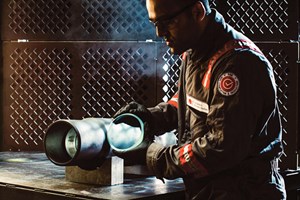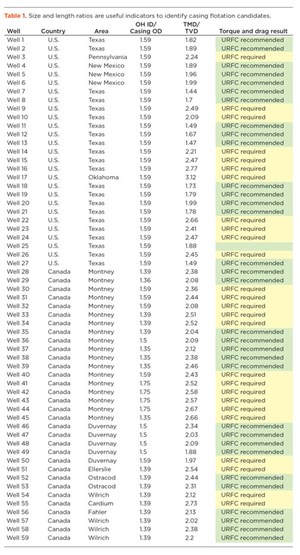Friction reducing flotation collar/optimal placement increases efficiency running casing in long laterals
Extended reach drilling provides longer laterals giving operators an economic advantage. However, these wells create challenges when engineers attempt to set casing strings to the target depth. Wells where the horizontal section is longer than the vertical section contain a larger contact surface, resulting in higher frictional forces. Rotating the casing is a traditional method to reduce frictional forces in the wellbore, but doing so requires higher quality casing and connections to support the string during rotation.
Another method to address these issues is to place a buoyancy barrier within the casing string to trap lighter fluid in the horizontal section and reduce friction. The reduction in weight and friction in the lateral portion of the wellbore contributes to significant improvement in casing running efficiency.
First-generation designs of buoyancy barrier tools featured metal subs containing burst discs requiring pump-down plugs to remove the wellbore restriction. The internal construction of these barriers often resulted in remedial work due to unexpected restrictions or upsets where completion tools could become stuck. A later version used a bursting ceramic disc. These discs did not require any additional plugs to be pumped, resulting in a simple, robust tool for the application. The issue with the ceramic discs has proven to be the size, sharpness, and hardness of the debris they create after burst. These tools required debris-catching tools or special landing sub equipment to be effective.
To reduce these operational challenges, National Oilwell Varco (NOV) provides the ultra-reach flotation collar (URFC), a next-generation flotation collar was developed that enables operators to reduce frictional forces in extended laterals without the need for other equipment to be installed in the casing string.
TECHNOLOGY
The URFC contains an embedded glass barrier that traps air or lowers density fluid in the downhole section of the casing and separates it from higher density fluid above, Fig. 1. The air section reduces the friction in the horizontal and build sections due to the buoyancy effects. The larger the difference between the mud weight and trapped fluid, the greater the buoyancy effect and friction reduction. In operation, after the casing string running begins, the operator fills the wellbore with connected drilling mud and casing joints to the float shoe and runs into the hole dry or with lighter fluid.

The operator calculates the number of joints to run to account for the buoyant section length, then couples the flotation collar with the casing joints to run as part of the production string. The wet section and the section above the flotation collar are then filled with heavier density fluid to contribute to the weight.
Once production casing reaches the target depth, a pre-determined pressure is applied, shattering the glass barrier into fine pieces and creating a full-bore flow path for the cementing operation. Glass particle sizes range from 5 mm to 10 mm in diameter. These small particles can be pumped through standard float equipment and other equipment installed downhole without risk of damage.
PLACEMENT METHODOLOGY
Placement of the flotation collar requires careful consideration. The primary goal when selecting the placement is to maximize the weight of the string in the vertical section of the well above the URFC while maximizing the buoyancy effect in the horizonal. Optimal positioning contributes to improved efficiency and results in maximum axial tensile force, enabling the casing string to run to target depth.
Each placement analysis requires specific wellbore information for proper positioning. A deviation survey showing the actual well path is the most critical component. In a typical well, the flotation collar is installed within the build section of the well. This is not always the case on large well pads, where the trajectory of the well may require different placement due to more complex wellbore geometry. The intermediate casing and open hole sizes are another key factor. Wells with smaller casing strings inside large diameter open hole sections will experience high frictional forces due to buckling. Finally, a casing tally of the string to be installed is required, especially in cases where multiple string types and sizes are planned.
When running the placement simulation, the operator conducts a sensitivity analysis to illustrate the effects of placement on the available hook-load. By keeping all other variables constant, and moving the location of the flotation collar, engineers can determine the optimal placement and factor this in when running the casing string.
CASE STUDIES
Using torque and drag analysis software to simulate multiple collar placements, NOV has successfully placed URFC in the optimal location to achieve maximum benefit. Deploying the URFC in wellbores in North America has resulted in significant time and cost savings.
Pennsylvania. An operator in Elk County, Pennsylvania, with a total depth (TD) of 16,000 ft and a true vertical depth (TVD) of 6,000 ft had an objective to complete a well that required making two bi-planar turns to reach the pay zone. Operators used a 5.5-in., 20-lb casing string to complete the well. They increased the length of the air section measured from the toe in increments of 1,000 ft and calculated the hook-load at the target depth and the landing point.
Canada. A company in western Canada deployed the casing flotation collar after experiencing a problem where the production string required excessive working to reach target depth, resulting in costly delays. A comparative trial was conducted with the first well running without URFC and the second well deployed the URFC close to optimal location. Each well had a total measure depth (TMD)/true vertical depth (TVD) ratio of 2.1 and 2.4, respectively. In the first well, without the casing flotation collar, at 13,125 ft measure depth (MD), the casing required reciprocation to meet target depth.
In contrast, the second well with the flotation collar installed ran smoothly into the well, enabling the company to make target depth while filling their casing above the tool every 1,650 ft. The flotation collar helped the company save 35 hr by running their casing in the second well. Since this trial, NOV has completed installations on the first two eight-well pads, and the operator has indicated they will be using this technology on future projects in the area.
Montney shale play. Another major operator working in the Montney formation deployed the URFC on 5.5-in. by 5-in. casing with a TMD/TVD ratio of 2.4. The torque and drag model confirmed the operator’s assessment that string would not be able to reach TD. The operator conducted a sensitivity analysis and selected the optimal placement for the casing installation. Comparison of the flotation model to the actual hook-load data for these wells showed a good match between the model and as-run data. This analysis helped engineering propose expanding the use of flotation on future wells on this project.
The ultra-reach flotation collar (URFC) can be installed in wells that do not necessarily require making target depth. Operators can install URFC to improve their run-in-hole efficiencies and ultimately save rig time. The Wilrich well in Canada had a TMD/TVD ratio of 2.1. The model shows that although it was possible to make target depth without the URFC installation, the significant improvements running URFC allowed the operator to run-in-hole more efficiently. This is a direct result of the significant friction reduction achieved through buoyancy. Successful deployment of the URFC on several wells in the area has influenced the operator to install the URFC on future wells.
ANALYSIS
Creating a torque and drag model aids in confirming whether a well is a candidate for casing flotation, but limited time and resources create employment challenges for larger products. Where creating torque and drag models is not feasible for every well, operators could attempt to build case studies using their best practices, to identify which wells are good candidates for advantages inherent to casing flotation technology. An analysis of parent casing or open hole ID versus production casing OD and TMD vs. TVD can aid in identifying initial candidates for further investigation.
Table 1 shows the ratio of OH ID/CASING OD and TMD/TVD for a variety of wells in North America. The size and length ratios shown are compared with the result of a full torque and drag analysis for each well. Neither metric can predict with certainty whether casing flotation was required or merely recommended. This is due to the torque and drag analysis considering the well path, buckling, side forces, and friction factors unique to each case.
Although further analysis is recommended, the size and length ratios serve as useful indicators for casing flotation candidates. Generally, if the size ratio is greater than 1.5 and the length ratio is greater than two, a well can be pulled for further analysis. Future analysis should be completed on wells that did not deploy or did not require casing flotation.
CONCLUSION
In the horizontal fracturing era, increasing reservoir contact by drilling longer laterals has been a consistent goal. In the past, rotating production strings to bottom required expensive casing and premium casing connections. The advent of interventionless casing flotation, such as the URFC, has allowed operators to extend the reach of their wells without the increased cost of premium casing.
Newer generations of flotation collars have improved the reliability and allowed the market to push the limits of their well designs. Previous generations required debris catching tools or pump down plugs to function effectively. Future generations of this technology will contain no moving parts and will disintegrate when activated, increasing access and reliability and resulting in the adoption of casing flotation on more wells.
A clear need for casing flotation can be proposed when the TMD/TVD ratio reaches two or greater. The placement discussion is critical to the success of the URFC. Larger pads and wells with unusual well paths require special attention, as these can result in different flotation collar placements outside the build section.
As the industry becomes more cost sensitive, the demand to lengthen laterals may continue to increase. The URFC offers a flexible, field-proven means to deploy casing without the need for interventions or installation of additional downhole components. NOV has built upon global knowledge to deploy the URFC in a variety of complex environments. Working closely with the operators to correct and improve torque and drag models has expanded the use of casing flotation. The case studies presented show some of the variation in sizes, application, and well parameters that benefit from casing flotation. WO
- Driving MPD adoption with performance-enhancing technologies (January 2024)
- Rig electrification drives down emissions, bolsters efficiency while improving onshore drilling economics (October 2023)
- Wellbore seal control and monitoring enhance deepwater MPD operations (October 2023)
- Advancing casing drilling to deepwater: Rethinking top hole well construction (August 2023)
- Mobile electric microgrids address power demands of high-intensity fracing (July 2023)
- Utilizing electronic data captured at the bit improves PDC design and drilling performance (July 2023)
- Applying ultra-deep LWD resistivity technology successfully in a SAGD operation (May 2019)
- Adoption of wireless intelligent completions advances (May 2019)
- Majors double down as takeaway crunch eases (April 2019)
- What’s new in well logging and formation evaluation (April 2019)
- Qualification of a 20,000-psi subsea BOP: A collaborative approach (February 2019)
- ConocoPhillips’ Greg Leveille sees rapid trajectory of technical advancement continuing (February 2019)



